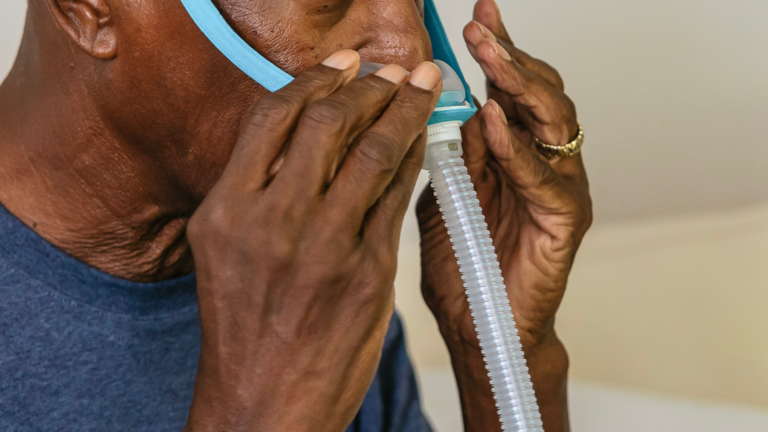Are you one of the many people that suffer from back pain? You may actually be suffering from sciatica. If you suffer from sciatica, then you need to talk to your doctor to see if a back brace is right for you! Aeroflow Healthcare can provide a back brace for sciatica and your health insurance may cover the cost!
What is Sciatica?
Sciatica is a term used to describe pain, weakness, numbness, tingling or other symptoms down the leg, following the path of the sciatic nerve. The sciatic nerve is the largest nerve of the leg formed by nerve roots from the low back converging at the buttock then splits into nerve branches past the knee.
Sciatica Symptoms

Sometimes Sciatica symptoms present as a straight line from the back all the way down to the toes, and other times it can skip spots where you may only feel it in the buttock, thigh, knee, calf, and/or foot and ankle. Sciatica can be constant or intermittent, meaning you can have the symptoms 100% of the time or 1-99% of the time. More common than not Sciatica symptoms will fluctuate depending on how you use your body – affected by various postures, movement, or positions.
Sciatic Nerve Pain
The problem with the term, “Sciatica” is it describes symptoms without identifying the cause. There are many causes of pain down the leg which can be misinterpreted or misdiagnosed as Sciatica. Most commonly, Sciatica is caused by irritated or “pinched” nerves exiting the spine. When irritated, low back nerves can radiate subtle-to-severe pain down the sciatic nerve and as far as into the toes.
Knowing this, it is especially important to pay attention to aches and pains in your back. However, you can have sciatic nerve pain caused by the lower back without ever having any lower back pain! The pain of sciatica is has a variety of causes including herniated discs, muscle strain, slippage of vertebrae so that it is out of line with the bone above or below it, or even spinal stenosis, a condition where the spinal canal narrows and adds pressure to the nerves that populate it.
Treating Sciatica
 So what can be done? Several things, such as X-rays, MRI’s and CT scans, can be done to see exactly what the structures look like; however, be careful – imaging will show you everything going on inside, but doesn’t tell you what’s relevant! As we age, we get wrinkles and gray hair on the outside. The same thing happens on the inside but it’s called “arthritis” and “degeneration.” Further, you can have Sciatica symptoms as a 20-year-old without any signs of age changes on the inside!
So what can be done? Several things, such as X-rays, MRI’s and CT scans, can be done to see exactly what the structures look like; however, be careful – imaging will show you everything going on inside, but doesn’t tell you what’s relevant! As we age, we get wrinkles and gray hair on the outside. The same thing happens on the inside but it’s called “arthritis” and “degeneration.” Further, you can have Sciatica symptoms as a 20-year-old without any signs of age changes on the inside!
A simple physical exam can be done where the doctor will have the patient lie on their back. The doctor will lift the patient’s legs, one at a time until the patient reports the pain. This test is very simple, but it can determine if the nerves are agitated and whether this pain is caused by an injured disc.
You can test yourself by doing a simple “slump test.” Take a seat and start by kicking your unaffected leg forward with toes pulled toward your nose. Now, bring your chin to your chest and slouch forward. Next, take the same steps on with the affected leg. Caution – go slowly! Your symptoms may literally zap you down the leg. If so, the pain and tension you feel is likely due to agitated nerves from an injured disc.
Good news: injured discs can heal and nerves can relax! There are a variety of treatment options for sciatica, though the severity and cause are taken into account when treatments are offered.
So can a back brace help treat sciatica pain?
A back brace can be essential for those suffering from Sciatica symptoms due to low back sensitivity. When your low back is sensitive previously normal movements can become much more tiresome and labored. A back brace works like a crutch to assist your core muscles to the absorb forces endured from activities of daily living, e.g., getting up/down, walking, bending, turning. Similar to how we shouldn’t rely on crutches for walking, a back brace shouldn’t be used as a long-term strategy pain management strategy.
However, back pain with associated pain medication (opioid) abuse is currently an overwhelming problem, so a back brace is a crucial device to have on hand, especially when you’ve had previous episodes of Sciatica. Yes, a back brace can help you avoid opioids! When used in conjunction with a rehabilitation exercise program, a back brace can help you recover faster from the source of your Sciatica symptoms.

Dr. RJ Burr, DC, Cert. MDT, CSC
Dr. Burr is a chiropractor in Plymouth, Michigan. He utilizes The McKenzie Method to help patients to pain-free living by providing strategies to empower them to take ownership of their recovery. He pursued his Doctor of Chiropractic from the National University of Health Sciences (NUHS) and earned certifications in Active Release Techniques, Titleist Performance Institue.





